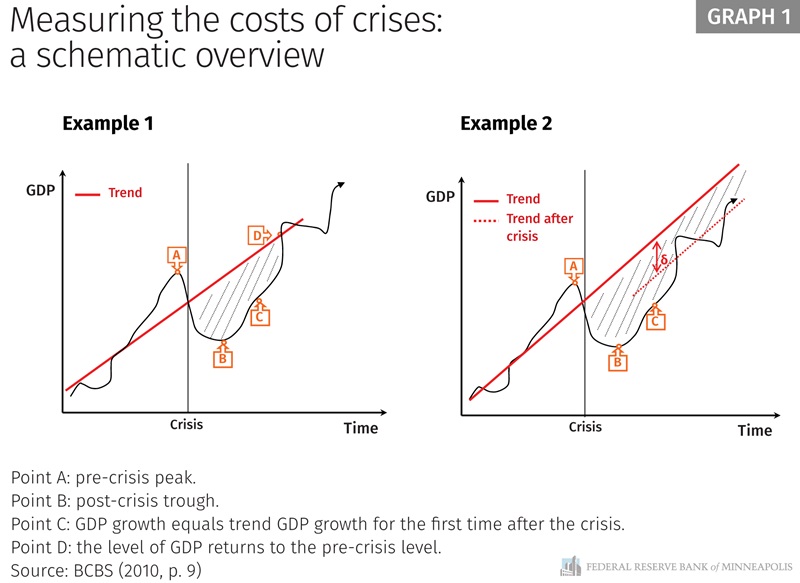Too-big-to-fail banks, which own The Clearing House, continue to try to argue that substantially raising their equity capital requirements would impose more costs than benefits on society. We understand why Clearing House owners—they call themselves “the world’s largest commercial banks”—oppose higher equity capital requirements. But their analysis remains flawed, with growing evidence that much higher equity requirements generate more benefits than costs. In the rest of this note, we explain why the recent Clearing House response to the Minneapolis Plan is wrong and, in fact, show that if the Basel Committee on Banking Supervision (BCBS) had discounted the way TCH does, the higher equity capital required by the Minneapolis Plan is an even better deal for taxpayers.
In a recent blog post, The Clearing House took issue with our interpretation of the nature of the BCBS (2010) baseline estimate of the cost of banking crises. In particular, TCH asserts that the 63 percent loss estimate, which Boyd, Kwak and Smith (2005, p. 993) refer to as “an absolute lower bound,” is insensitive to changes in assumptions about discounting and trend growth, while we asserted in Response 8 of the final Minneapolis Plan that the 63 percent cost of a crisis should be adjusted in response to changes in those assumptions. We have reviewed the record, and it continues to show that the 63 percent loss figure in BCBS (2010) should be interpreted as a 3 percent permanent loss, discounted at 5 percent with no growth.
The 63 percent loss figure that BCBS (2010) centered its analysis on is the median of a collection of 13 estimates of cumulative losses listed in Table A1.1 on page 35 of BCBS (2010)—“all comparable studies” (p. 11). It comes from Boyd et al. (2005)—more on this later. The BCBS report uses the 63 percent figure when reporting the expected annual benefits of a reduction in crisis probability in Table 2 (p. 13) for crises having a “long-lasting or small permanent effect on output.” Nearby text says that it “could be thought of as corresponding to a moderate permanent effect on output (e.g., δ = 3%),” where δ is the size of a permanent level shift in the path for trend output as depicted in Example 2 of Graph 1 on p. 9 (also shown below). In Table 8 on p. 29, the gross and net benefit calculations using the 63 percent loss estimate fall under the heading of a “moderate permanent effect,” which is consistent with the 3 percent permanent loss described on p. 13. And, finally, Table A1.1 on p. 35 lists the 63 percent figure under the heading of “Cumulative losses: Infinite horizon (permanent effects).”1 Boyd et al. (2005) is also included in the category of “Cumulative losses allowing for permanent effects” in Table A1.2 on p. 38. All of this leads us to believe that the BCBS also interpreted the 63 percent loss estimate as a moderate permanent effect, that is, a 3 percent permanent loss, discounted at 5 percent. We will continue to do so unless the BCBS issues a formal correction to their 2010 report.
But TCH does not just try to revise the words of the BCBS paper. They also rely on a figure that its own authors view as “inappropriate.”
Let’s explain by turning to the source of the 63 percent estimate: Boyd et al. (2005). This paper does a careful job of using the data available at the time to estimate the long-run, cumulative costs of banking crises. They report results using several approaches. (BCBS 2010 reports two estimates from Boyd et al. 2005 but labels them differently. We use the Boyd et al. 2005 labeling in what follows.) Method 1 of Boyd et al. (2005) produces an estimate of 302 percent for the present value of the losses from banking crises. Method 2 projects future losses using data that start at the end of the crisis rather than including observations from the crisis period as was done in Method 1. This alternative approach required dropping several countries whose crises were still ongoing at the end of the sample period, but overall were quite similar to the baseline estimates. As we indicated in Response 7, we consider the 302 percent estimate to be technically more robust than the 63 percent estimate. Our assessment was based on the derivation of the 63 percent measure. That estimate was derived by computing the present value of losses as shown in Example 2 of Graph 1 on p. 9 of BCBS (2010) and reproduced below. However, while Method 1 in Boyd et al. (2005) includes losses from beyond point C (the permanent level shift caused by a banking crisis) and assumes trend output growth, their 63 percent estimate truncates the calculation at the end of the data sample. As mentioned before, some of the countries in the sample had crises that were still ongoing at the end of the sample period. There are gaps between actual and trend output in all but four countries, and those gaps were “usually sizable” (p. 994). Boyd et al. (2005) also state that not extrapolating the gaps while computing losses was “surely inappropriate” (p. 994). An additional few years of data would have almost definitely resulted in an estimate greater than 63 percent. In terms of Graph 1, the truncation point was to the right of the vertical line, but where it was relative to points B or C varied, depending on the timing of the crisis relative to the end of the then-available data.

In sum, an examination of the method used to derive the 63 percent figure shows that it is not particularly robust, nor does it include any permanent effects. And the actual written words of the BCBS analysis support why we think the proper way to think about the 63 percent cost measure is as a permanent 3 percent loss discounted at 5 percent without growth, including its grouping with other such estimates in Tables A1.1 and A1.2 of BCBS (2010).
TCH is wrong even if we assume that the 63 percent estimate is insensitive to discounting as TCH contends. There are 13 estimates of cumulative losses listed in Table A1.1 on p. 35. Six of those are derived from papers that only estimated the permanent component of the losses (δ in Graph 1). The cumulative estimates were computed by BCBS using a 5 percent discount rate assuming no growth (as we stated in Response 8). The median of those estimates was 63 percent, the actual-data-only estimate from Boyd et al. (2005). Had the BCBS allowed for output growth in their calculations, the estimates of cumulative losses from the “δ-only” estimates would have been bigger, potentially shifting the median since only some of the estimates would change. BCBS (2010, p. 36) reports that the median would increase to 82 percent if a discount rate of 2.5 percent had been used. This would also be the case if 2.5 percent growth were assumed in addition to the 5 percent discount rate.
TCH maintained the 5 percent discount rate, but assumed 4 percent growth. That results in a net discount rate of 1 percent, which we used in Response 8. Recalculating the cumulative losses for the “δ-only” estimates would cause the median to increase to 202 percent. This would produce a positive net benefit from Step 1 of the Minneapolis Plan of roughly $37,000 per person. Not quite the $72,000 we reported in Response 8, but still sizable.
In fact, any change, either to the δ, the discount rate, the growth rate or the configuration of temporary losses, that adds up to losses greater than 100 percent of GDP makes our recommended higher equity capital requirement a net positive for society. For example, at 3 percent growth (and a 2 percent net discount rate), the median in Table A1.1 shifts to 102 percent, just past where costs equal benefits. We also note that the lowest “δ-only” estimate is a 2 percent permanent reduction in trend output. All it takes is half of that, a δ equal to 1 percent, to yield a 101 percent cumulative loss with TCH’s preferred 5 percent discounting and 4 percent growth assumptions. Finally, Boyd et al. (2005) report a loss estimate of 95 percent that was derived by truncating the calculations at Point C in the right panel of Graph 1 regardless of whether output had returned to its precrisis trend, ruling out permanent level shifts from banking crises (p. 986). This approach treats all of the crises in their sample equally by not limiting the calculation to the available data. Substituting this (sounder) finite-horizon estimate for the 63 percent value would also put costs roughly equal to benefits for our recommended equity requirement of 23.5 percent.
Estimating the costs of banking crises is a difficult task, and critically important for formulating regulations. But not all estimates are equally correct. When it comes to the cost of a crisis, the available evidence suggests that they are large and long-lived and not small and temporary as too-big-to-fail banks would have the public believe.
Endnote
1 We think this is the table TCH meant to refer to in paragraph 11 of their blog post, not Table A1.2.
References
Basel Committee on Banking Supervision (BCBS). 2010. An Assessment of the Long-Term Economic Impact of Stronger Capital and Liquidity Requirements. August. Available at https://www.bis.org/publ/bcbs173.pdf.
Boyd, John H., Sungkyu Kwak, and Bruce Smith. 2005. The Real Output Losses Associated with Modern Banking Crises. Journal of Money, Credit and Banking 37 (6), 977-99.




